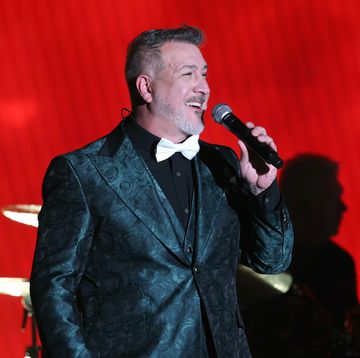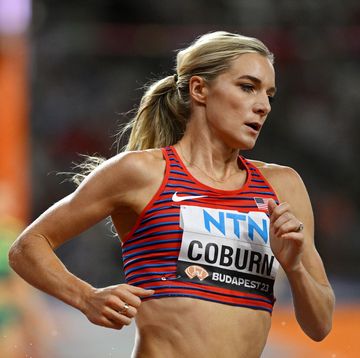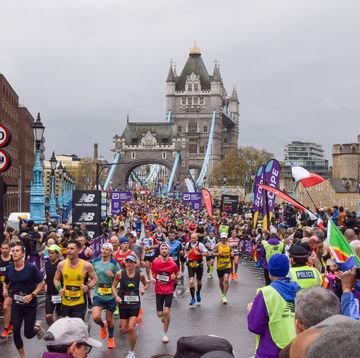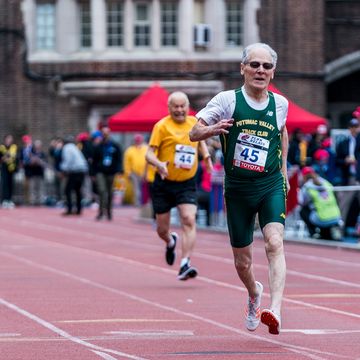In his quest to beat the Guinness world record for the most marathons finished in a year (157), Australian Trent Morrow spent the month of December completing 26 marathons in four different states. The year-end sprint gave him a total of 161 official marathons run on five continents in 2013. Morrow, who bills himself as “Marathon Man” and races in a blue shirt emblazoned with a red “M” like Superman, posted a celebratory pic on Facebook upon completion of his final race on December 31. “Dream! Believe! Achieve! Anything is possible,” he wrote.
Except, unbeknownst to Morrow, the current Guinness record holder, Larry Macon (seen above), a trial lawyer from San Antonio, had been trying to best his own mark. Unlike Morrow, who documented his every race, Macon stayed under the radar and endured 239 sanctioned marathon races between December 1, 2012 and November 30, 2013.
Meanwhile, over in Denmark, running coach Annette Fredskov one-upped Morrow and Macon by finishing 366 marathons between July 15, 2012 and July 14, 2013. Fredskov, however, didn’t compete exclusively in certified road races; rather, she spent most days circling a 3.48-mile loop near her home. She dubbed that the “Fredskov Marathon,” though it more closely resembled a training run.
So who actually set the record for most marathons in a year?
Here is our attempt to set the record as straight as it can be, given that no sport governing body has outlined any rules for this feat of human endurance. For this comparison, we are citing examples only of runners who have run set marathons and not anyone who has done transcontinental runs and covered the equivalent of a marathon or more every day. That precludes someone like Australian Tom Denniss who averaged 26.2 miles per day as part of a run around the world and, more recently, the Australian couple Alan Murray and Janette Murray-Wakelin, who averaged a marathon a day as they toured their country on foot.
First, it’s important to define what constitutes a “marathon race.” According to Ken Young, co-founder of the Association of Road Race Statisticians, his organization counts anything that is a “bona fide competition.”
“Among the criteria defining a bona fide competition are the race is advertised in advance, all competitors must start at the same time and all competitors must start at the same start line and run the same course,” Young says, adding, “there should also be a defined course.”
While the ARRS does not recognize a record for the most marathons completed in a single year, Young thinks Fredskov’s races—many of which she put on herself, but always had at least two other “competitors”—should count. “As far as I can tell, her races meet the definition of bona fide competition,” he says. “A race cannot be disqualified because one of the competitors was responsible for organizing the race.”
Guinness sees it a bit differently.
For starters, Guinness defines “year” by 365 consecutive days, not as a calendar year. There must be at least two independent witnesses who sign statements at each race, as well as photo and video evidence. (The independent witnesses must check the progress of the participant at the beginning and end of the race and at a minimum of five different points throughout the course.) Each marathon must be officially organized, open to the public and advertised as such (i.e., not organized specifically for the purposes of this record attempt) and all of the race courses must be professionally measured. In addition, a letter from the race organizer and one other independent witness must be provided for each marathon confirming the time it took the individual to complete the race. Finally, a printout of the official race results from every race must be included in the documentation, along with a link to the race results online.
It’s an extensive, detailed list that covers its bases and leaves little room for subjectivity. Judging by its requirements, Guinness will not recognize Fredskov’s achievement. Fredskov said she will still try to submit her accomplishment to Guinness, but emphasizes that her goal was to better understand “what people can do with their minds and bodies” following her multiple sclerosis diagnosis in 2009.
The 41-year-old mother of two ran one marathon every day, except on the last day when she ran two. During this 365-day stretch, she made running her job and tried to hit five hours for the distance. She allowed herself to walk, but only on hills. “It helped me to recover and catch my breath,” she says. “I normally never do that, but during the project it was okay for me because I had to listen to my body and do what I needed to do to get through.” Fredskov has written a book, 366 Marathons in 365 Days, about her experience.
With an eye toward breaking the Guinness record, Morrow participated solely in official marathons. When Runner’s World Newswire spoke with him right before Christmas, he said he was unaware of Macon’s latest record-breaking endeavor (and this reporter didn’t have the heart to tell him about it). Morrow spent much of 2013 based in Los Angeles and posted his results on his website.
“The financial cost was the biggest challenge,” says the self-funded 40-year-old. “We’re talking 350,000-odd miles in flight, more than 40,000 miles driving and close to 5,000 miles on trains across five continents.” Following a major weight loss, Morrow tackled his first marathon in 2008. Hooked, he set off on the worldwide adventure shortly thereafter. “This is a decision I’ve made to show people what is possible,” he says.
Though Morrow won’t break the record, his effort raises another question: Should speed be a factor? For instance, does it make a difference if someone runs the marathons versus run/walking them? Many people will say that Morrow deserves credit for usually aiming for a self-challenging pace; he finished 51 of his marathons in the 4:00 range, with a fastest of 3:46:26.
Macon, 69, could be said to take a more leisurely approach to most of his marathons. A partner at one of the most powerful law firms in the country, Akin, Gump, and knows all too well the exacting specifications of Guinness. He has already set the yearly marathon record four times, and recently sent Guinness three boxes of documentary evidence to support his latest claim of 239 marathons.
“The hard part is traveling from place to place, making connections and going 2-3 days without sleep,” he says. “Once you get to the race, you can always run, walk or crawl to finish the 26.2 miles.” Macon used to run them all, but, during this most recent conquest, he sometimes walked the entire way. “It’s survival,” he admits.
Speaking in a hearty Texan drawl, Macon shared tales from the road in 2013.
There was the time when he had driven all night to a small town in South Dakota, missed a road closed sign in the pouring rain and slid into a ditch at 4 a.m. “The police gave me three tickets for violating a traffic sign that said ‘don’t go any further,’” he recalls. “I was lucky because the bridge was actually out and if I had gone 100 feet further I’d driven right off the road.”
Another time he was to fly from Forth Worth to New Orleans, but a tornado alert shut down Dallas/Fort Worth Airport. Macon rented a car and sped through the night to reach New Orleans by dawn. “I arrived just as the race started and was the last starter by about 10 minutes,” he says. “When I finally finished, though, I couldn’t find my keys.” He staggered back to his car, where he had left his keys in the ignition and the vehicle still running. “I was very lucky it wasn’t stolen!” he says.
Deeming himself as a “tad competitive,” Macon was aware of Morrow’s attempt, but insists 239 happened “organically.” Unlike in past years, Macon didn’t update his Marathon Maniacs webpage with his completed marathons this past year. When asked if that was to keep his undertaking on the down low, Macon replied in an email, “I wish that I could say that it was part of a well-thought-out secret plan. Unfortunately, I just fell behind and never started. One of my resolutions is to do better in 2014. Unfortunately, I made the same resolution in 2013.”
When asked if he could ever push past 239, Macon points to Guinness as being his biggest obstacle.
“They are talking about putting in new requirements, like a race can’t be all downhill,” he says. “They just put that in and that might bite me. If you’re trying to do much more than 100 you’ve got to go to some really small, obscure and informal ones. There is a balance to meet the Guinness requirements and still do races that are professionally run. If they start enforcing these new rules, it will be tough for anyone, me included, to beat 239.”
Or maybe not. Last Friday, Macon told Newswire he racked up 255 marathons finishes for the 2013 calendar year. In theory, he’s already broken his soon-to-be record of 239, even though it’s not even ratified yet. Now that’s one way to stay a step ahead of the competition.
Shot over Memorial Day weekend of 2009, the video below details the logistics of a typical weekend for Macon.
The Race for the Most Marathons in a Year
Three runners tried to break the record in 2013.
by Matt McCue
Advertisement - Continue Reading Below

Controversy Over Boston’s 6-Hour Results Cutoff
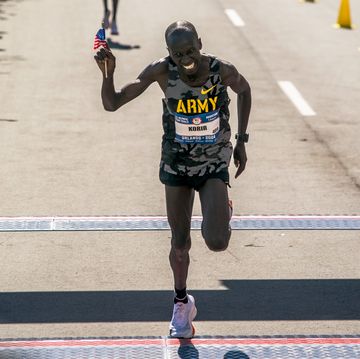
Only Two U.S. Men in Olympic Marathon?
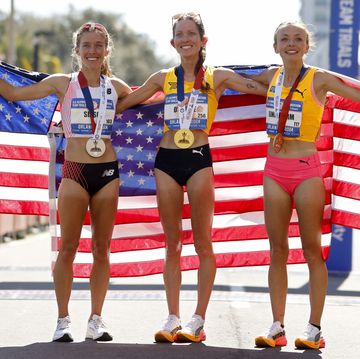
U.S. Women's Marathon Team Will Race in NYC

Kipchoge Faced Harassment After Kiptum’s Death
Advertisement - Continue Reading Below
Advertisement - Continue Reading Below

